Critical Reflection: Nursing Incident, Patient Safety, and Standards
VerifiedAdded on 2022/10/04
|7
|1690
|395
Essay
AI Summary
This essay critically reflects on a nursing incident where a nurse administered a crushed medication intravenously, resulting in a patient's death. It details the case background, including the patient's medical history and the nurse's actions, and discusses the consequences of the incident, highlighting violations of medication safety standards and the impact on patient safety. The essay then analyzes the incident using Rolfe's reflective model, examining the nurse's actions and the emotional responses to the event. It emphasizes the importance of adhering to the NSQHS standards, consulting with colleagues, and participating in advanced training to prevent similar adverse events. The essay concludes by reinforcing the critical role of medication safety and the need for improved compliance with healthcare standards to ensure patient safety.
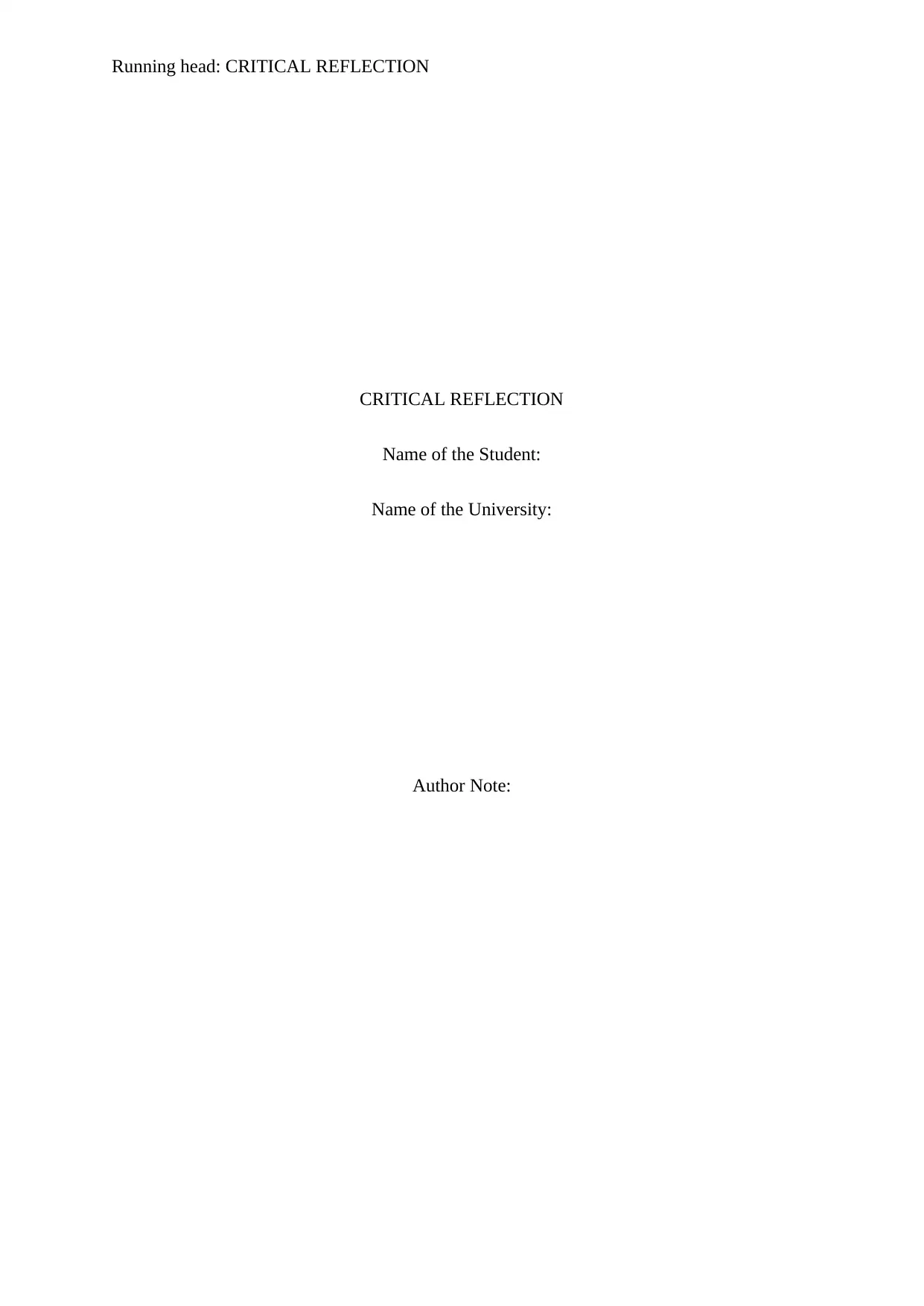
Running head: CRITICAL REFLECTION
CRITICAL REFLECTION
Name of the Student:
Name of the University:
Author Note:
CRITICAL REFLECTION
Name of the Student:
Name of the University:
Author Note:
Paraphrase This Document
Need a fresh take? Get an instant paraphrase of this document with our AI Paraphraser
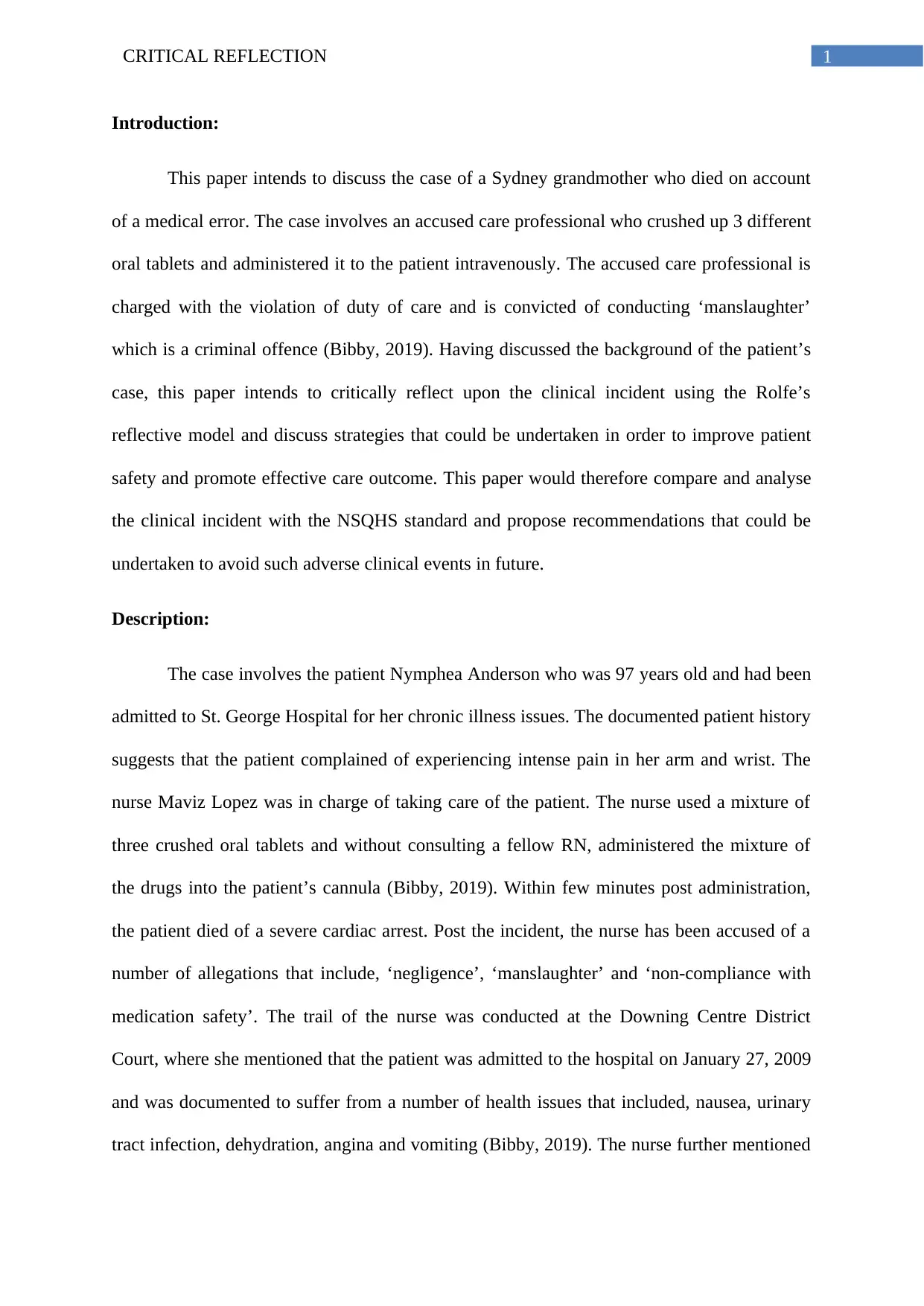
1CRITICAL REFLECTION
Introduction:
This paper intends to discuss the case of a Sydney grandmother who died on account
of a medical error. The case involves an accused care professional who crushed up 3 different
oral tablets and administered it to the patient intravenously. The accused care professional is
charged with the violation of duty of care and is convicted of conducting ‘manslaughter’
which is a criminal offence (Bibby, 2019). Having discussed the background of the patient’s
case, this paper intends to critically reflect upon the clinical incident using the Rolfe’s
reflective model and discuss strategies that could be undertaken in order to improve patient
safety and promote effective care outcome. This paper would therefore compare and analyse
the clinical incident with the NSQHS standard and propose recommendations that could be
undertaken to avoid such adverse clinical events in future.
Description:
The case involves the patient Nymphea Anderson who was 97 years old and had been
admitted to St. George Hospital for her chronic illness issues. The documented patient history
suggests that the patient complained of experiencing intense pain in her arm and wrist. The
nurse Maviz Lopez was in charge of taking care of the patient. The nurse used a mixture of
three crushed oral tablets and without consulting a fellow RN, administered the mixture of
the drugs into the patient’s cannula (Bibby, 2019). Within few minutes post administration,
the patient died of a severe cardiac arrest. Post the incident, the nurse has been accused of a
number of allegations that include, ‘negligence’, ‘manslaughter’ and ‘non-compliance with
medication safety’. The trail of the nurse was conducted at the Downing Centre District
Court, where she mentioned that the patient was admitted to the hospital on January 27, 2009
and was documented to suffer from a number of health issues that included, nausea, urinary
tract infection, dehydration, angina and vomiting (Bibby, 2019). The nurse further mentioned
Introduction:
This paper intends to discuss the case of a Sydney grandmother who died on account
of a medical error. The case involves an accused care professional who crushed up 3 different
oral tablets and administered it to the patient intravenously. The accused care professional is
charged with the violation of duty of care and is convicted of conducting ‘manslaughter’
which is a criminal offence (Bibby, 2019). Having discussed the background of the patient’s
case, this paper intends to critically reflect upon the clinical incident using the Rolfe’s
reflective model and discuss strategies that could be undertaken in order to improve patient
safety and promote effective care outcome. This paper would therefore compare and analyse
the clinical incident with the NSQHS standard and propose recommendations that could be
undertaken to avoid such adverse clinical events in future.
Description:
The case involves the patient Nymphea Anderson who was 97 years old and had been
admitted to St. George Hospital for her chronic illness issues. The documented patient history
suggests that the patient complained of experiencing intense pain in her arm and wrist. The
nurse Maviz Lopez was in charge of taking care of the patient. The nurse used a mixture of
three crushed oral tablets and without consulting a fellow RN, administered the mixture of
the drugs into the patient’s cannula (Bibby, 2019). Within few minutes post administration,
the patient died of a severe cardiac arrest. Post the incident, the nurse has been accused of a
number of allegations that include, ‘negligence’, ‘manslaughter’ and ‘non-compliance with
medication safety’. The trail of the nurse was conducted at the Downing Centre District
Court, where she mentioned that the patient was admitted to the hospital on January 27, 2009
and was documented to suffer from a number of health issues that included, nausea, urinary
tract infection, dehydration, angina and vomiting (Bibby, 2019). The nurse further mentioned
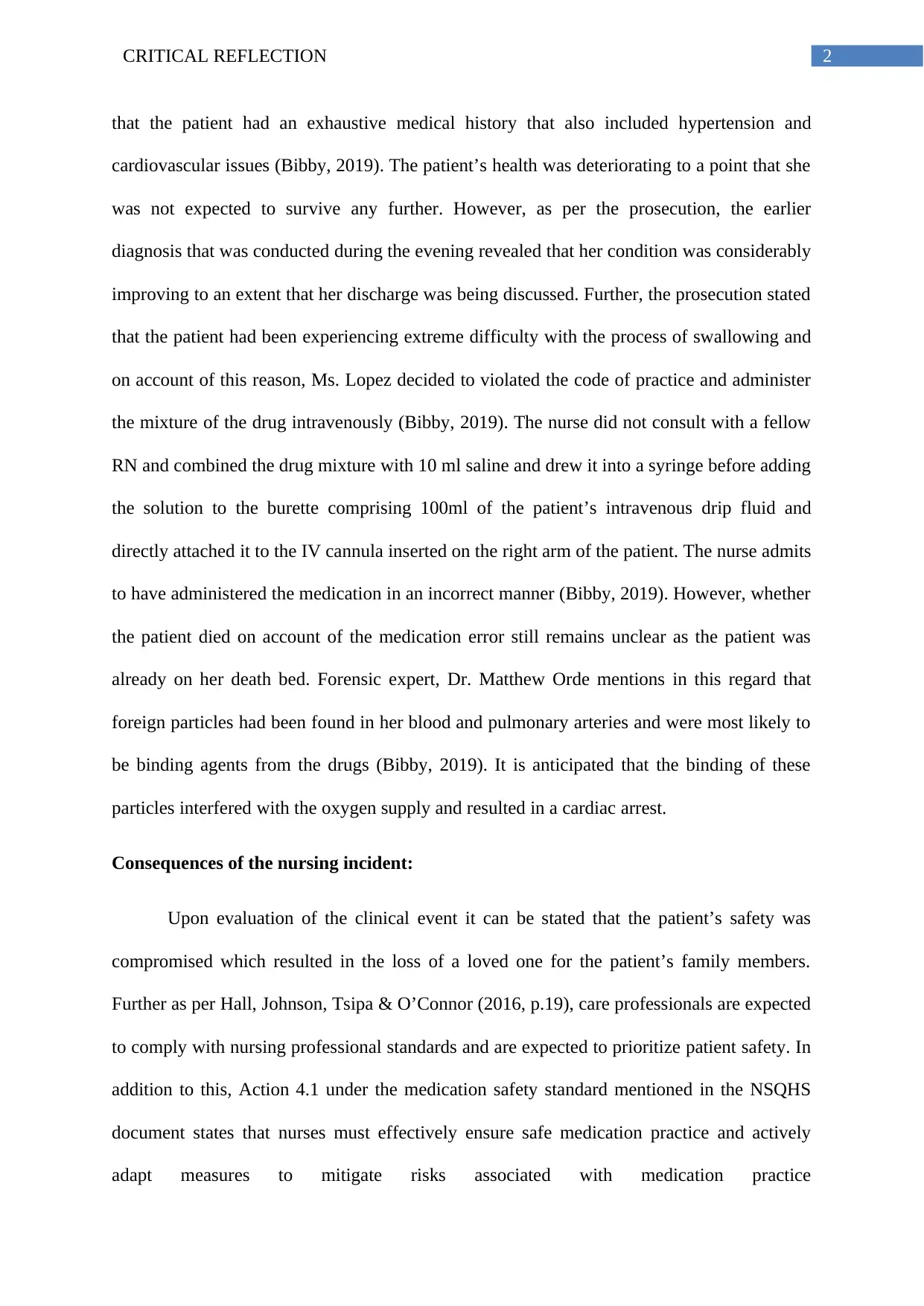
2CRITICAL REFLECTION
that the patient had an exhaustive medical history that also included hypertension and
cardiovascular issues (Bibby, 2019). The patient’s health was deteriorating to a point that she
was not expected to survive any further. However, as per the prosecution, the earlier
diagnosis that was conducted during the evening revealed that her condition was considerably
improving to an extent that her discharge was being discussed. Further, the prosecution stated
that the patient had been experiencing extreme difficulty with the process of swallowing and
on account of this reason, Ms. Lopez decided to violated the code of practice and administer
the mixture of the drug intravenously (Bibby, 2019). The nurse did not consult with a fellow
RN and combined the drug mixture with 10 ml saline and drew it into a syringe before adding
the solution to the burette comprising 100ml of the patient’s intravenous drip fluid and
directly attached it to the IV cannula inserted on the right arm of the patient. The nurse admits
to have administered the medication in an incorrect manner (Bibby, 2019). However, whether
the patient died on account of the medication error still remains unclear as the patient was
already on her death bed. Forensic expert, Dr. Matthew Orde mentions in this regard that
foreign particles had been found in her blood and pulmonary arteries and were most likely to
be binding agents from the drugs (Bibby, 2019). It is anticipated that the binding of these
particles interfered with the oxygen supply and resulted in a cardiac arrest.
Consequences of the nursing incident:
Upon evaluation of the clinical event it can be stated that the patient’s safety was
compromised which resulted in the loss of a loved one for the patient’s family members.
Further as per Hall, Johnson, Tsipa & O’Connor (2016, p.19), care professionals are expected
to comply with nursing professional standards and are expected to prioritize patient safety. In
addition to this, Action 4.1 under the medication safety standard mentioned in the NSQHS
document states that nurses must effectively ensure safe medication practice and actively
adapt measures to mitigate risks associated with medication practice
that the patient had an exhaustive medical history that also included hypertension and
cardiovascular issues (Bibby, 2019). The patient’s health was deteriorating to a point that she
was not expected to survive any further. However, as per the prosecution, the earlier
diagnosis that was conducted during the evening revealed that her condition was considerably
improving to an extent that her discharge was being discussed. Further, the prosecution stated
that the patient had been experiencing extreme difficulty with the process of swallowing and
on account of this reason, Ms. Lopez decided to violated the code of practice and administer
the mixture of the drug intravenously (Bibby, 2019). The nurse did not consult with a fellow
RN and combined the drug mixture with 10 ml saline and drew it into a syringe before adding
the solution to the burette comprising 100ml of the patient’s intravenous drip fluid and
directly attached it to the IV cannula inserted on the right arm of the patient. The nurse admits
to have administered the medication in an incorrect manner (Bibby, 2019). However, whether
the patient died on account of the medication error still remains unclear as the patient was
already on her death bed. Forensic expert, Dr. Matthew Orde mentions in this regard that
foreign particles had been found in her blood and pulmonary arteries and were most likely to
be binding agents from the drugs (Bibby, 2019). It is anticipated that the binding of these
particles interfered with the oxygen supply and resulted in a cardiac arrest.
Consequences of the nursing incident:
Upon evaluation of the clinical event it can be stated that the patient’s safety was
compromised which resulted in the loss of a loved one for the patient’s family members.
Further as per Hall, Johnson, Tsipa & O’Connor (2016, p.19), care professionals are expected
to comply with nursing professional standards and are expected to prioritize patient safety. In
addition to this, Action 4.1 under the medication safety standard mentioned in the NSQHS
document states that nurses must effectively ensure safe medication practice and actively
adapt measures to mitigate risks associated with medication practice
⊘ This is a preview!⊘
Do you want full access?
Subscribe today to unlock all pages.

Trusted by 1+ million students worldwide
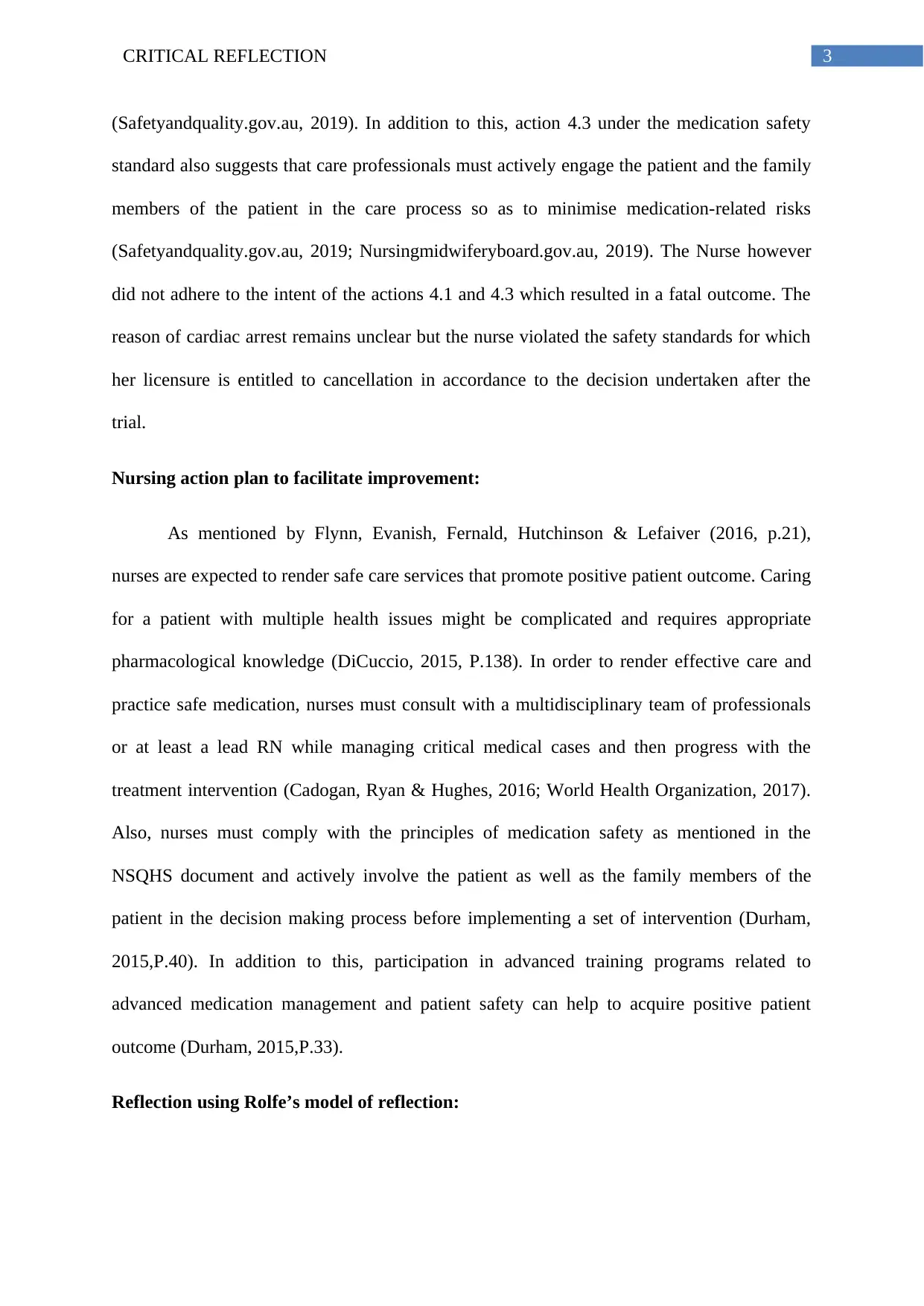
3CRITICAL REFLECTION
(Safetyandquality.gov.au, 2019). In addition to this, action 4.3 under the medication safety
standard also suggests that care professionals must actively engage the patient and the family
members of the patient in the care process so as to minimise medication-related risks
(Safetyandquality.gov.au, 2019; Nursingmidwiferyboard.gov.au, 2019). The Nurse however
did not adhere to the intent of the actions 4.1 and 4.3 which resulted in a fatal outcome. The
reason of cardiac arrest remains unclear but the nurse violated the safety standards for which
her licensure is entitled to cancellation in accordance to the decision undertaken after the
trial.
Nursing action plan to facilitate improvement:
As mentioned by Flynn, Evanish, Fernald, Hutchinson & Lefaiver (2016, p.21),
nurses are expected to render safe care services that promote positive patient outcome. Caring
for a patient with multiple health issues might be complicated and requires appropriate
pharmacological knowledge (DiCuccio, 2015, P.138). In order to render effective care and
practice safe medication, nurses must consult with a multidisciplinary team of professionals
or at least a lead RN while managing critical medical cases and then progress with the
treatment intervention (Cadogan, Ryan & Hughes, 2016; World Health Organization, 2017).
Also, nurses must comply with the principles of medication safety as mentioned in the
NSQHS document and actively involve the patient as well as the family members of the
patient in the decision making process before implementing a set of intervention (Durham,
2015,P.40). In addition to this, participation in advanced training programs related to
advanced medication management and patient safety can help to acquire positive patient
outcome (Durham, 2015,P.33).
Reflection using Rolfe’s model of reflection:
(Safetyandquality.gov.au, 2019). In addition to this, action 4.3 under the medication safety
standard also suggests that care professionals must actively engage the patient and the family
members of the patient in the care process so as to minimise medication-related risks
(Safetyandquality.gov.au, 2019; Nursingmidwiferyboard.gov.au, 2019). The Nurse however
did not adhere to the intent of the actions 4.1 and 4.3 which resulted in a fatal outcome. The
reason of cardiac arrest remains unclear but the nurse violated the safety standards for which
her licensure is entitled to cancellation in accordance to the decision undertaken after the
trial.
Nursing action plan to facilitate improvement:
As mentioned by Flynn, Evanish, Fernald, Hutchinson & Lefaiver (2016, p.21),
nurses are expected to render safe care services that promote positive patient outcome. Caring
for a patient with multiple health issues might be complicated and requires appropriate
pharmacological knowledge (DiCuccio, 2015, P.138). In order to render effective care and
practice safe medication, nurses must consult with a multidisciplinary team of professionals
or at least a lead RN while managing critical medical cases and then progress with the
treatment intervention (Cadogan, Ryan & Hughes, 2016; World Health Organization, 2017).
Also, nurses must comply with the principles of medication safety as mentioned in the
NSQHS document and actively involve the patient as well as the family members of the
patient in the decision making process before implementing a set of intervention (Durham,
2015,P.40). In addition to this, participation in advanced training programs related to
advanced medication management and patient safety can help to acquire positive patient
outcome (Durham, 2015,P.33).
Reflection using Rolfe’s model of reflection:
Paraphrase This Document
Need a fresh take? Get an instant paraphrase of this document with our AI Paraphraser
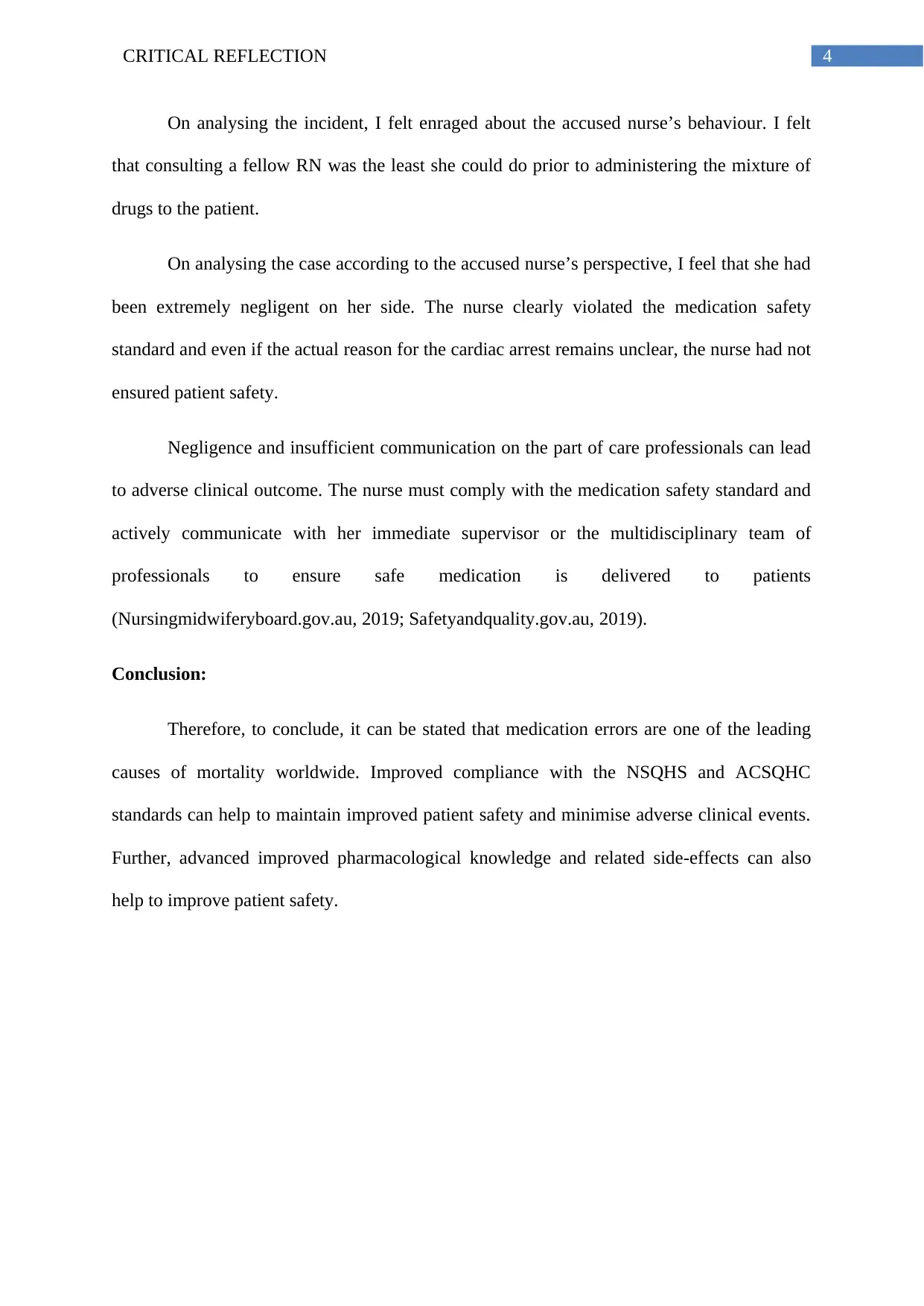
4CRITICAL REFLECTION
On analysing the incident, I felt enraged about the accused nurse’s behaviour. I felt
that consulting a fellow RN was the least she could do prior to administering the mixture of
drugs to the patient.
On analysing the case according to the accused nurse’s perspective, I feel that she had
been extremely negligent on her side. The nurse clearly violated the medication safety
standard and even if the actual reason for the cardiac arrest remains unclear, the nurse had not
ensured patient safety.
Negligence and insufficient communication on the part of care professionals can lead
to adverse clinical outcome. The nurse must comply with the medication safety standard and
actively communicate with her immediate supervisor or the multidisciplinary team of
professionals to ensure safe medication is delivered to patients
(Nursingmidwiferyboard.gov.au, 2019; Safetyandquality.gov.au, 2019).
Conclusion:
Therefore, to conclude, it can be stated that medication errors are one of the leading
causes of mortality worldwide. Improved compliance with the NSQHS and ACSQHC
standards can help to maintain improved patient safety and minimise adverse clinical events.
Further, advanced improved pharmacological knowledge and related side-effects can also
help to improve patient safety.
On analysing the incident, I felt enraged about the accused nurse’s behaviour. I felt
that consulting a fellow RN was the least she could do prior to administering the mixture of
drugs to the patient.
On analysing the case according to the accused nurse’s perspective, I feel that she had
been extremely negligent on her side. The nurse clearly violated the medication safety
standard and even if the actual reason for the cardiac arrest remains unclear, the nurse had not
ensured patient safety.
Negligence and insufficient communication on the part of care professionals can lead
to adverse clinical outcome. The nurse must comply with the medication safety standard and
actively communicate with her immediate supervisor or the multidisciplinary team of
professionals to ensure safe medication is delivered to patients
(Nursingmidwiferyboard.gov.au, 2019; Safetyandquality.gov.au, 2019).
Conclusion:
Therefore, to conclude, it can be stated that medication errors are one of the leading
causes of mortality worldwide. Improved compliance with the NSQHS and ACSQHC
standards can help to maintain improved patient safety and minimise adverse clinical events.
Further, advanced improved pharmacological knowledge and related side-effects can also
help to improve patient safety.
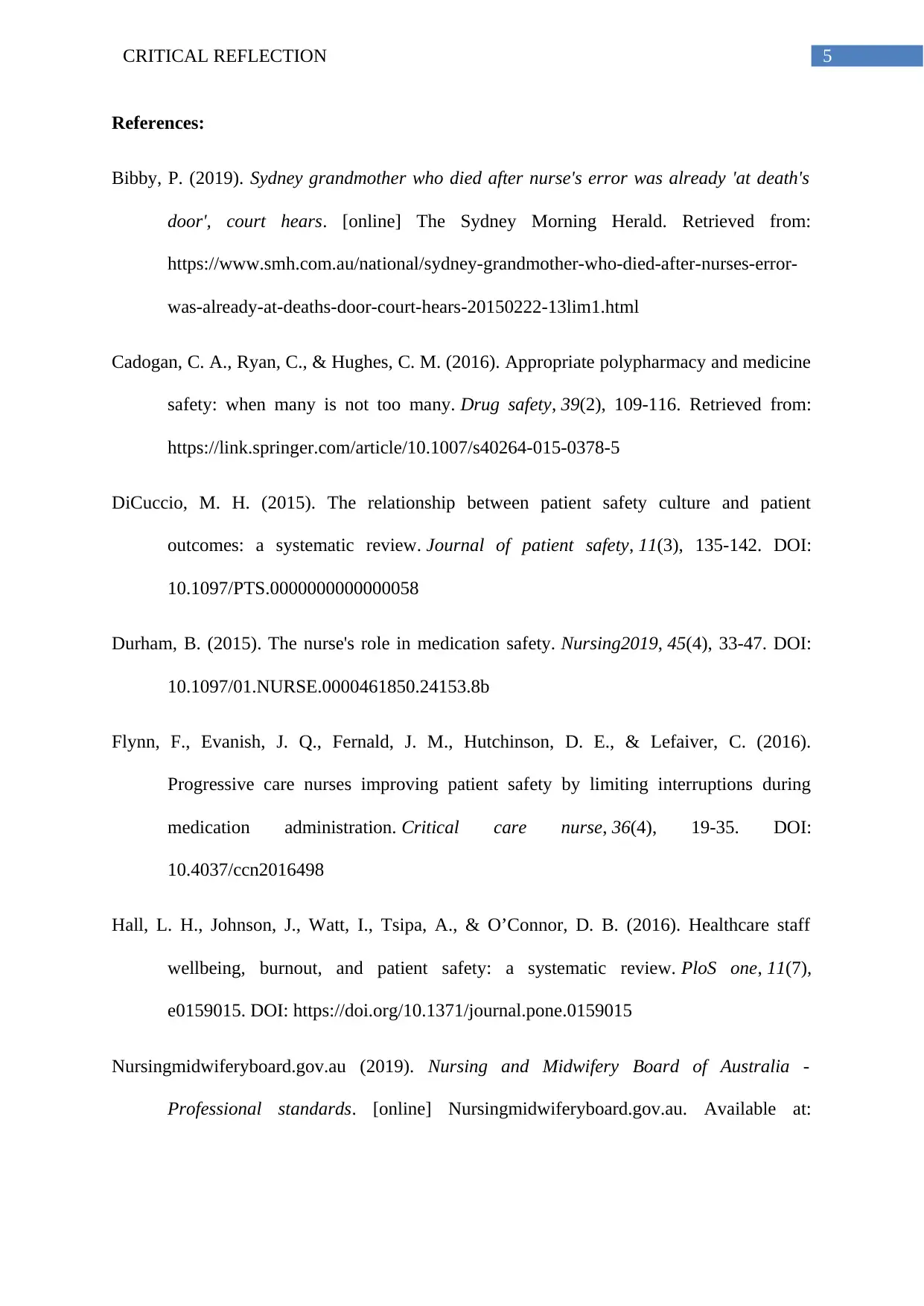
5CRITICAL REFLECTION
References:
Bibby, P. (2019). Sydney grandmother who died after nurse's error was already 'at death's
door', court hears. [online] The Sydney Morning Herald. Retrieved from:
https://www.smh.com.au/national/sydney-grandmother-who-died-after-nurses-error-
was-already-at-deaths-door-court-hears-20150222-13lim1.html
Cadogan, C. A., Ryan, C., & Hughes, C. M. (2016). Appropriate polypharmacy and medicine
safety: when many is not too many. Drug safety, 39(2), 109-116. Retrieved from:
https://link.springer.com/article/10.1007/s40264-015-0378-5
DiCuccio, M. H. (2015). The relationship between patient safety culture and patient
outcomes: a systematic review. Journal of patient safety, 11(3), 135-142. DOI:
10.1097/PTS.0000000000000058
Durham, B. (2015). The nurse's role in medication safety. Nursing2019, 45(4), 33-47. DOI:
10.1097/01.NURSE.0000461850.24153.8b
Flynn, F., Evanish, J. Q., Fernald, J. M., Hutchinson, D. E., & Lefaiver, C. (2016).
Progressive care nurses improving patient safety by limiting interruptions during
medication administration. Critical care nurse, 36(4), 19-35. DOI:
10.4037/ccn2016498
Hall, L. H., Johnson, J., Watt, I., Tsipa, A., & O’Connor, D. B. (2016). Healthcare staff
wellbeing, burnout, and patient safety: a systematic review. PloS one, 11(7),
e0159015. DOI: https://doi.org/10.1371/journal.pone.0159015
Nursingmidwiferyboard.gov.au (2019). Nursing and Midwifery Board of Australia -
Professional standards. [online] Nursingmidwiferyboard.gov.au. Available at:
References:
Bibby, P. (2019). Sydney grandmother who died after nurse's error was already 'at death's
door', court hears. [online] The Sydney Morning Herald. Retrieved from:
https://www.smh.com.au/national/sydney-grandmother-who-died-after-nurses-error-
was-already-at-deaths-door-court-hears-20150222-13lim1.html
Cadogan, C. A., Ryan, C., & Hughes, C. M. (2016). Appropriate polypharmacy and medicine
safety: when many is not too many. Drug safety, 39(2), 109-116. Retrieved from:
https://link.springer.com/article/10.1007/s40264-015-0378-5
DiCuccio, M. H. (2015). The relationship between patient safety culture and patient
outcomes: a systematic review. Journal of patient safety, 11(3), 135-142. DOI:
10.1097/PTS.0000000000000058
Durham, B. (2015). The nurse's role in medication safety. Nursing2019, 45(4), 33-47. DOI:
10.1097/01.NURSE.0000461850.24153.8b
Flynn, F., Evanish, J. Q., Fernald, J. M., Hutchinson, D. E., & Lefaiver, C. (2016).
Progressive care nurses improving patient safety by limiting interruptions during
medication administration. Critical care nurse, 36(4), 19-35. DOI:
10.4037/ccn2016498
Hall, L. H., Johnson, J., Watt, I., Tsipa, A., & O’Connor, D. B. (2016). Healthcare staff
wellbeing, burnout, and patient safety: a systematic review. PloS one, 11(7),
e0159015. DOI: https://doi.org/10.1371/journal.pone.0159015
Nursingmidwiferyboard.gov.au (2019). Nursing and Midwifery Board of Australia -
Professional standards. [online] Nursingmidwiferyboard.gov.au. Available at:
⊘ This is a preview!⊘
Do you want full access?
Subscribe today to unlock all pages.

Trusted by 1+ million students worldwide
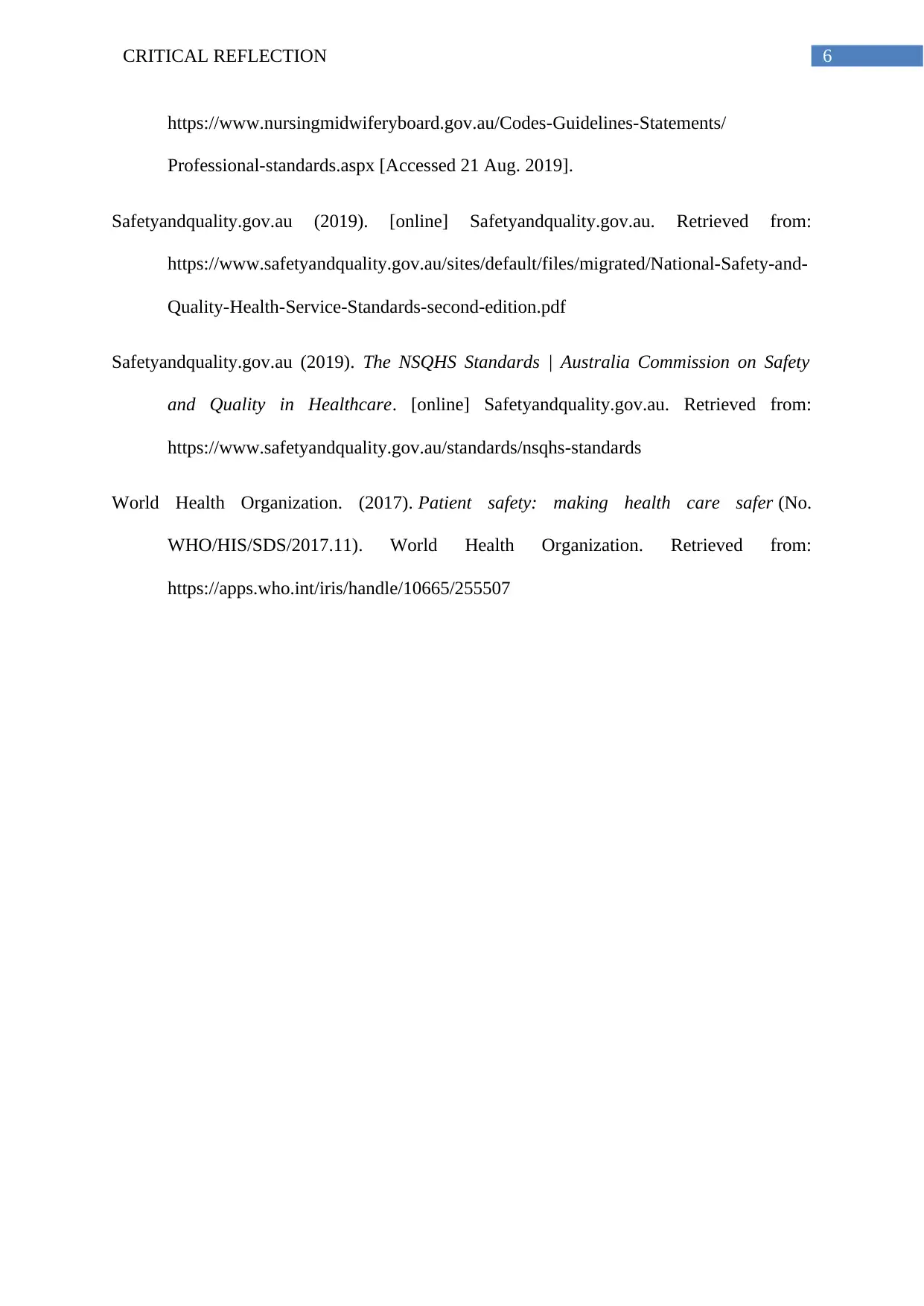
6CRITICAL REFLECTION
https://www.nursingmidwiferyboard.gov.au/Codes-Guidelines-Statements/
Professional-standards.aspx [Accessed 21 Aug. 2019].
Safetyandquality.gov.au (2019). [online] Safetyandquality.gov.au. Retrieved from:
https://www.safetyandquality.gov.au/sites/default/files/migrated/National-Safety-and-
Quality-Health-Service-Standards-second-edition.pdf
Safetyandquality.gov.au (2019). The NSQHS Standards | Australia Commission on Safety
and Quality in Healthcare. [online] Safetyandquality.gov.au. Retrieved from:
https://www.safetyandquality.gov.au/standards/nsqhs-standards
World Health Organization. (2017). Patient safety: making health care safer (No.
WHO/HIS/SDS/2017.11). World Health Organization. Retrieved from:
https://apps.who.int/iris/handle/10665/255507
https://www.nursingmidwiferyboard.gov.au/Codes-Guidelines-Statements/
Professional-standards.aspx [Accessed 21 Aug. 2019].
Safetyandquality.gov.au (2019). [online] Safetyandquality.gov.au. Retrieved from:
https://www.safetyandquality.gov.au/sites/default/files/migrated/National-Safety-and-
Quality-Health-Service-Standards-second-edition.pdf
Safetyandquality.gov.au (2019). The NSQHS Standards | Australia Commission on Safety
and Quality in Healthcare. [online] Safetyandquality.gov.au. Retrieved from:
https://www.safetyandquality.gov.au/standards/nsqhs-standards
World Health Organization. (2017). Patient safety: making health care safer (No.
WHO/HIS/SDS/2017.11). World Health Organization. Retrieved from:
https://apps.who.int/iris/handle/10665/255507
1 out of 7
Related Documents
Your All-in-One AI-Powered Toolkit for Academic Success.
+13062052269
info@desklib.com
Available 24*7 on WhatsApp / Email
![[object Object]](/_next/static/media/star-bottom.7253800d.svg)
Unlock your academic potential
Copyright © 2020–2025 A2Z Services. All Rights Reserved. Developed and managed by ZUCOL.





